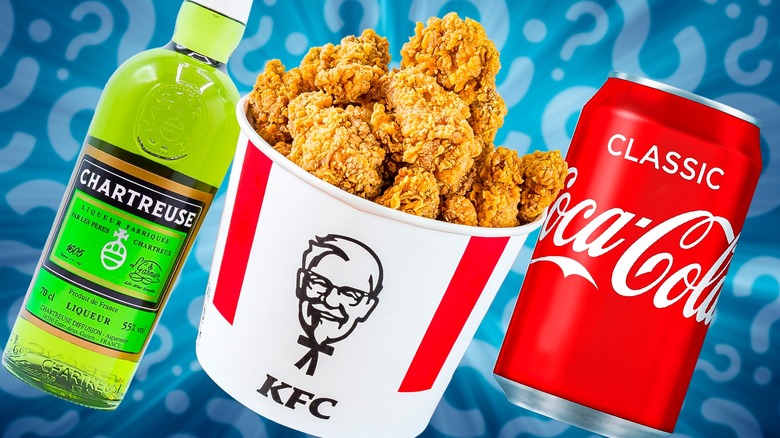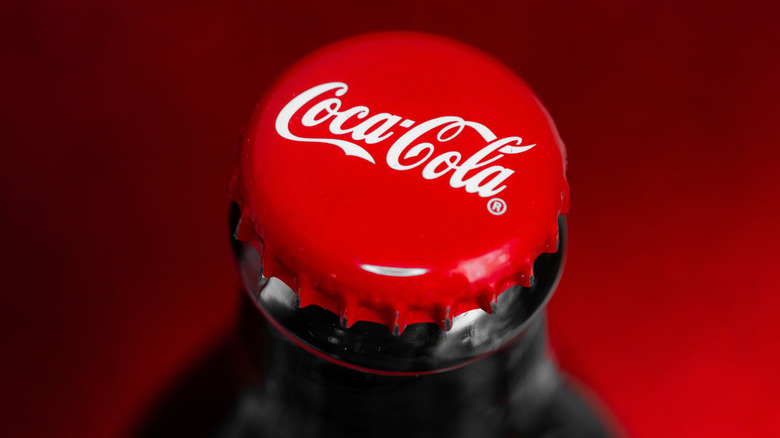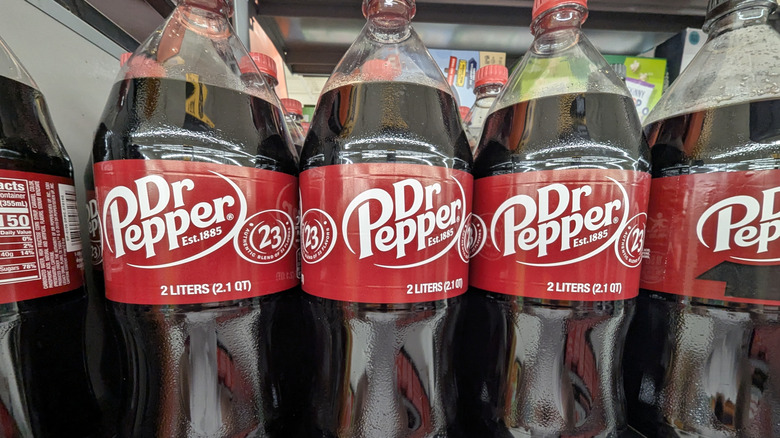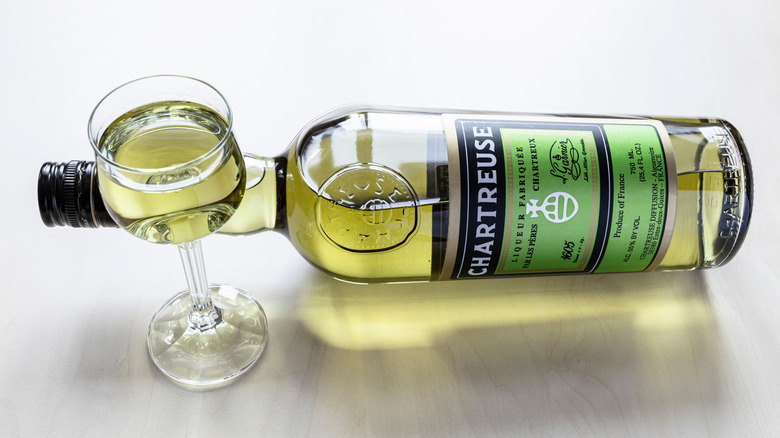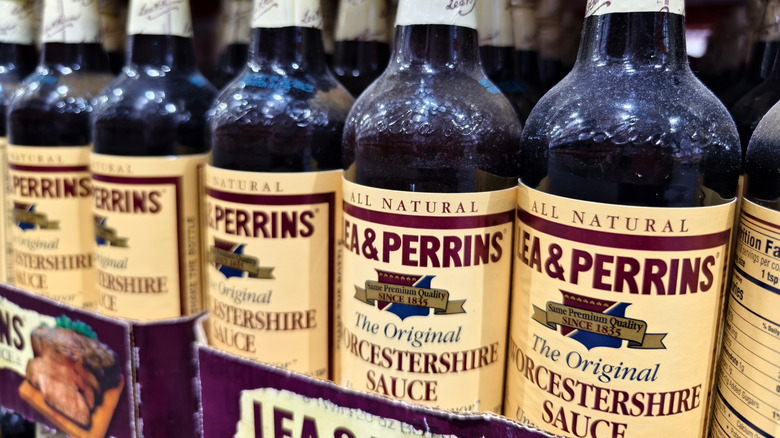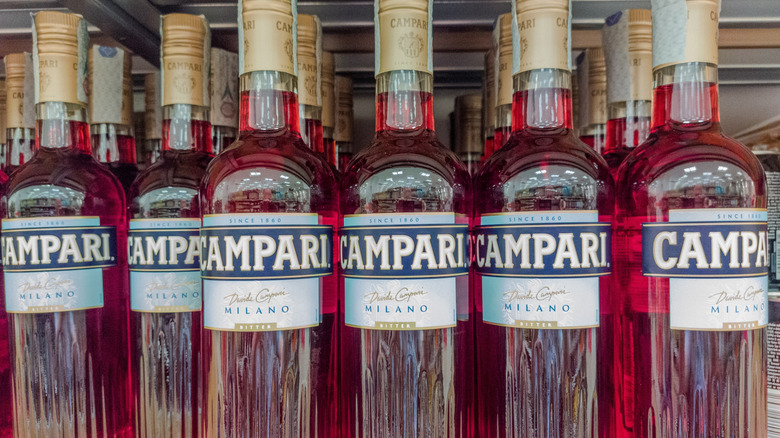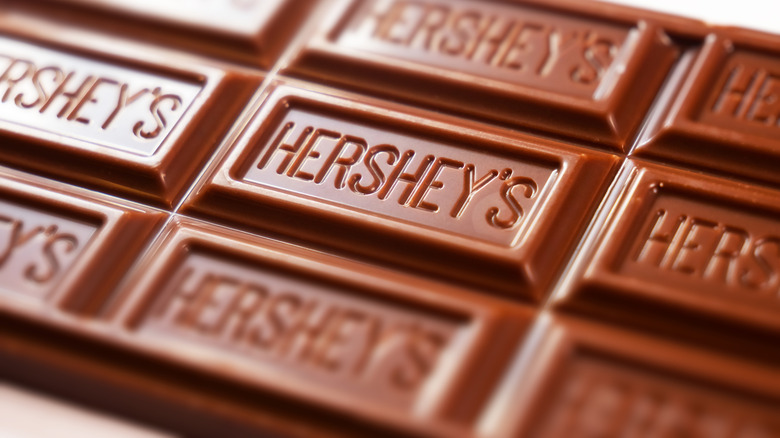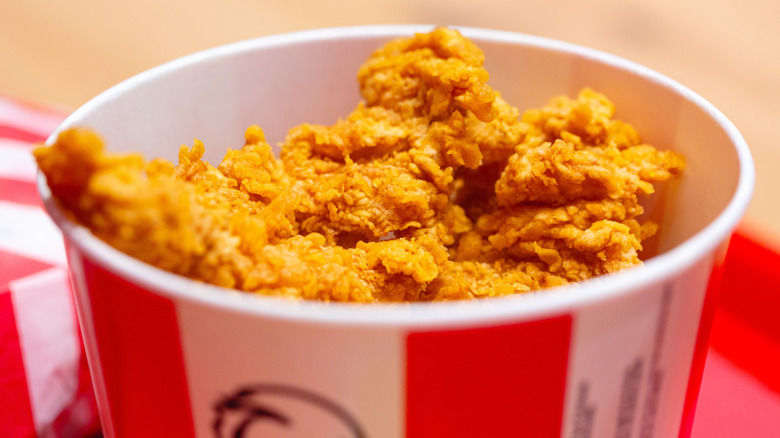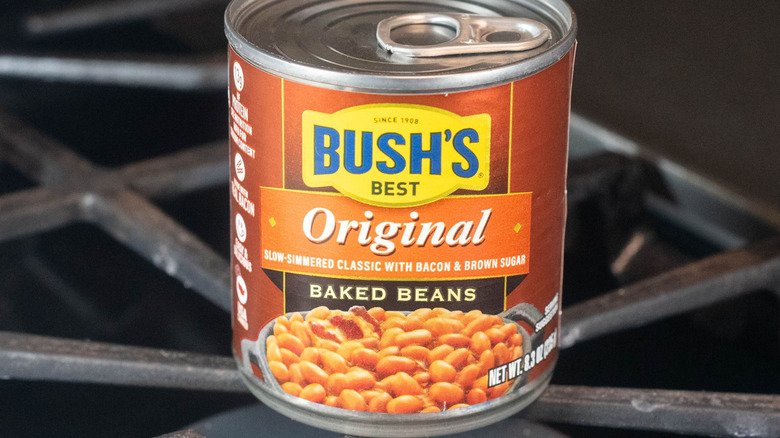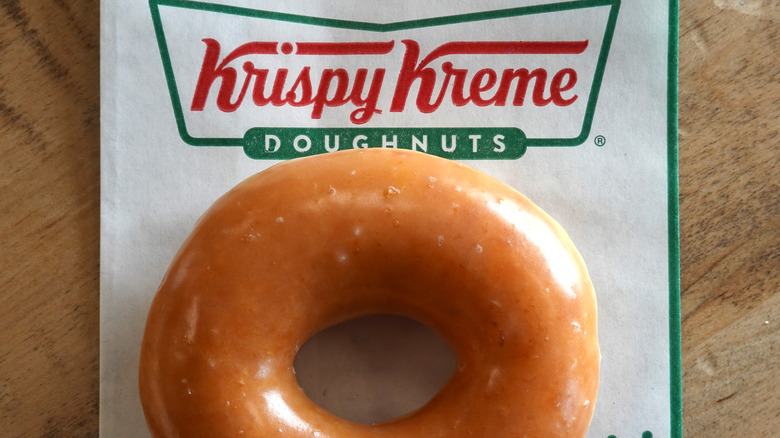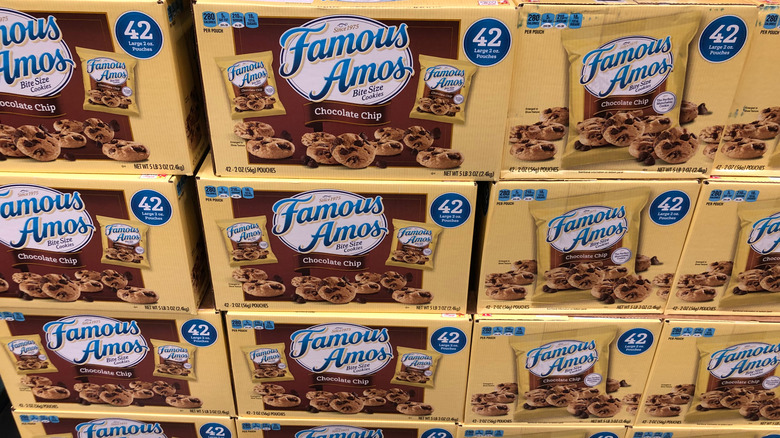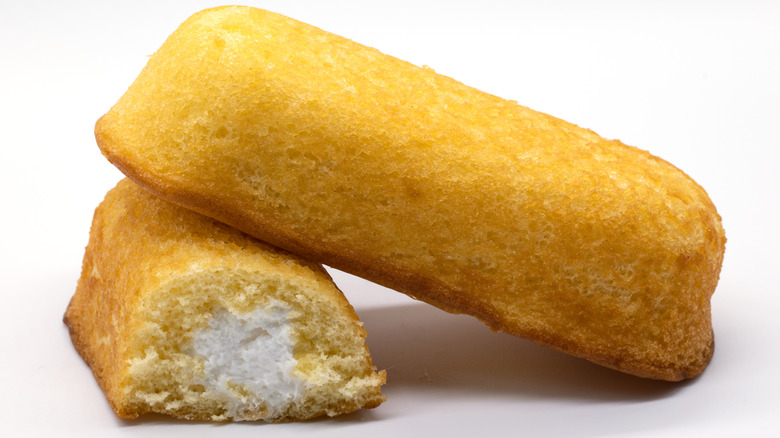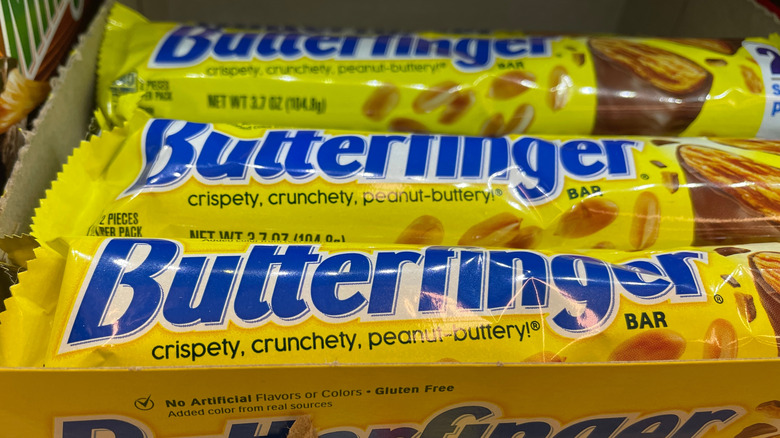The Most Famous Secret Recipes In Food And Drink History
It seems like the best and most authentic way for a food brand to get out the message that its product is not only one-of-a-kind, but better than anything the competition might offer is with a special "secret recipe." That instantly creates lore and an aura of mystery for a food or the company that makes it that's also unimpeachable and unchallengeable, because that unique way of making the product has to be kept secret to maintain integrity. Along with the pomp and enigmatic nature surrounding the food, that's all part of marketing and product differentiation.
Some of the most famous and iconic foods are supposedly made with a secret recipe — and that secret recipe is in part why they're so famous and iconic. Like a special family recipe, those trade secrets are kept guarded, or literally under lock and key, and almost notoriously so. Here are some very well-known foods, drinks, restaurant items, and packaged goods all made with a certain number of ingredients and techniques that the general public will likely never hear about.
Coca-Cola
A code name of "7X" indicates some next-generation military-grade weapon, but it's actually subject to more clandestine measures. It's the secret formula for the syrup that makes Coca-Cola. Invented by Atlanta pharmacist John Pemberton in 1886 and sold at the soda fountain at Jacobs' Pharmacy, Coca-Cola took off as a mixed on the premises drink and then a bottled one by the end of the 19th century.
First marketed as a medicinal drink, Coca-Cola's name is derived from its sources of pep: the caffeine-loaded extract of the kola nut, and the bit of cocaine taken from the coca leaf. While Coca-Cola's working formula stopped using actual cocaine in 1903, it's still made with coca leaf. All of the cocaine has been removed before Coca-Cola plants making the syrup receive the ingredient, made possible by a special arrangement with federal government agencies.
It turns out that the coca leaf extracts may have something to do with that precise Coca-Cola flavor. Coca-Cola historian Mark Pendergrast claims to have found a possible 7X recipe in the early 1990s, and in 2011, "This American Life" broadcast a similar one found in a photograph of 19th century soda fountain recipes published in the Atlanta-Journal Constitution in 1979. A batch made with the latter recipe reportedly tasted close to real Coke, but not exactly, as the re-creators couldn't obtain coca leaf. The true recipe resides in a locked bank vault, and only a few of the highest-ranking Coca-Cola executives may access it.
Dr Pepper
What even is Dr Pepper? It's very sweet, a little spicy, and very fruity, but beyond those generic modifiers, it's hard to explain the flavor profile of the widely distributed beverage of Texas origin. Of all the major soda varieties on the market, only Dr Pepper and its imitators like Mr. Pibb don't have a clearly stated and executed flavor. There are supposedly 23 secret flavors in Dr Pepper, and none of the manufacturers that have made the product have ever admitted to what any of them are. Some say it tastes a bit like cherry, others swear that it contains prune juice.
No one associated with the production of Dr Pepper will likely ever provide conclusive information. At any given time, no more than three executives at the company that makes Dr Pepper are aware of the recipe for the beverage. In 2009, a rare document collector found a late 1800s sales lodger in Shamrock, Texas, that included a handwritten list of ingredients for "D Peppers Pepsin Bitter" that likely was intended for W.B. Morrison and Co. Old Corner Drug Store — the Waco, Texas, business where Dr Pepper was first sold in 1885. Representatives of Dr Papper's parent company at the time, Dr Pepper Snapple Group, saw the list and said the scribbled recipe wasn't accurate. Familiar with the true recipe, they claimed that what was found were likely the instructions for a different, medicinal drink.
Chartreuse
The Chartreuse we know today started out as a monk-made elixir. Chartreuse is a liqueur available in two varieties — a green version, and a yellow one with more sugar and a lower ABV. It's produced from a recipe that's more than 400 years old, and which has been kept remarkably and completely secret for all that time. Way back in the 1700s, the monks cloistered at the Chartreuse monastery outside of Paris perfected its combination of 130 herbs and plants to make what they called the "Elixir of Long Life." That was based on a manuscript that predecessor monks at Chartreuse had seen as early as the 1600s. Yellow Chartreuse was an offshoot of that original, green Chartreuse, and that emerged in 1840.
In the 21st century, both kinds of Chartreuse are only made in one place: a distillery in Aiguenoire, located in southeastern France. Monks from the Chartreuse monastery still oversee the production, as they're also the secret keepers as far as the recipe is concerned. Even among that religious group is the recipe guarded: Only two monks at any time are given the proper clearances to so much as even look at the very old documents bearing the recipe.
Lea & Perrins Worcestershire sauce
Lea & Perrins, the tangy, slightly-sweet, flavor-packed concoction used in cooking and as a condiment, is made from a secret recipe that began as a failed re-creation of another sauce. According to internal lore, in the 1830s, former Bengal governor Lord Sandys visited Worcester, England, and he asked pharmacists and shopkeepers John Wheeley Lea and William Henry Perrins to make for him a special sauce like he'd had in India. Based on Sandys' parameters, Lea and Perrins made two batches, hated how badly they tasted, and left it all to rot in the cellar. A year-and-a-half later, a co-worker found the sauce, and they discovered it had aged into something delicious.
Lea & Perrins Worcestershire Sauce hit stores locally in 1837 and was an international hit by 1849. Imitations flooded the market, allowing for a court decree in 1906 that resulted in all bottles carrying a declaration that the stuff inside was "Original and Genuine" Worcestershire sauce. That explains how no knockoff ever quite tastes like the original and genuine one.
Lea & Perrins is now part of the Kraft Heinz catalog, which has never revealed the full list of items it takes to make such a unique condiment. Over the years, it's been stated or determined that white vinegar, sugar, molasses, salt, water, onions, anchovies, garlic, tamarind, cloves, and a chili pepper extract are used. How much of each is a mystery, as are the identities of many other flavoring agents used.
Campari
Created in the Lombardy region of what's now Italy in 1860, Campari is a deep-red aperitif intended to be consumed before a meal, but is probably more famous as the key factor in sophisticated and old-fashioned cocktails like the Americano, Boulevardier, and Negroni. The liqueur's uniquely bitter, fruity, and medicinal taste comes from the infusion of an amalgam of peels, herbs, and spices in water and neutral alcohol. But what exactly those are has never been revealed in the 160-plus years of Campari's availability. Experts say that rhubarb, ginseng, quinine, and bitter orange play a role, but nobody who could say for sure ever has.
Not even the person in charge of the Campari plant in Novi Ligure, Italy, knows precisely what goes into a bottle of the red bitters. They're only told that the herbs used are semi-dehydrated. Across the whole operation, a grand total of five employees gets to know what's in Campari. They work at the Officinal Plants Center, placing whatever plants and herbs they use into proper proportions in bags which they label "herbs for Campari." Then they send the otherwise unidentified ingredients to another team of workers that handles the process of infusing them in water and alcohol.
Hershey's chocolate
After establishing The Hershey Chocolate Company to mostly make and market cocoa powder, baking chocolate, and chocolate coverings for other candy companies' products, Milton Hershey introduced the iconic Hershey's Chocolate Bar in 1900. Presented as a thin brick of rectangular pips, the Hershey bar made chocolate a mass-produced treat that was affordable to the masses, while also establishing a certain flavor profile and sensibility that would persist in American-style chocolate.
Some people think Hershey's chocolate tastes like puke, or at the very least, lacking the nuance of traditional or European chocolate. That could be due to the rumored presence of a fatty acid called butyric acid, which can be used as a preservative or which shows up in the milk fats used in chocolate, which come to the fore in a process called lipolysis.
The Hershey Chocolate Company claims that it doesn't use butyric acid in its famous bars – stated ingredients on the label are just milk chocolate, milk fat, soy lecithin, an emulsifier, and natural flavor. The full and complete recipe is a trade secret, so while it hasn't revealed the presence of butyric acid, it's well known that Hershey's does employ lipolysis, which could help that chemical form. The bar is only possible due to Hershey's protected lipolysis practice, or "The Hershey Process." As the milk stabilizes and solidifies the chocolate, butyric acid results.
Kentucky Fried Chicken's Original Recipe
The 11 KFC herbs and spices used to season and flavor the fried (but really pressure-cooked) chicken are probably the most famous and protected trade secrets in the food world. In 1930, Harlan Sanders started selling his special Southern fried chicken out of a motel in Corbin, Kentucky, utilizing a blend of almost a dozen agents in the breading. After he sold the business in 1956, Kentucky Fried Chicken became an international juggernaut, despite Colonel Sanders actually hating his own fast food chain because he believed the quality of the food suffered enormously after he could no longer control it. Still, the new KFC dutifully kept using Sanders' breading recipe.
In the 1960s and beyond, Kentucky Fried Chicken was so popular that in inspired a host of imitators, very few of which lasted very long because none could offer that distinctive, familiar, and delicious mixture of 11 herbs and spices found in the Original Recipe chicken. The company still goes to great lengths to hide what those 11 ingredients may be. It contracts with two suppliers that each make about half of the concoction, which then gets sent to a third company for a final blending. Despite old, handwritten recipes supposedly written by Col. Sanders surfacing over the years, KFC brass denies the accuracy of those lists and keeps the real one in a vault in Louisville, Kentucky. Only two executives at any time know the recipe or can look at it.
Bush's Baked Beans
For decades, Bush's Baked Beans has made the "Secret Family Recipe" that's vital to its line of canned beans the focal point of its marketing campaign. Third-generation company leader Jay Bush is also Bush's Baked Beans' pitchman, and he's purportedly told only one individual the exact blend of spices and other ingredients to make the simmering liquid that surrounds and flavors all those navy beans: his dog, Duke, who is forever thwarted in his quest to sell off the recipe.
But Bush's Original Baked Beans really are made with a proprietary formula. All the company will reveal about the recipe, adopted in 1969 after 60 years in business, is that bespoke-cured bacon and brown sugar are used, along with an unidentified mix of spices. On the label, cans of Bush's Baked Beans purport to include "natural flavor," a vague umbrella term that could cover most anything food-safe, legal, and not known to cause allergic reactions.
Krispy Kreme glazed doughnuts
Doughnuts are so inexpensive and often so interchangeable, that to sell more than 1.63 billion doughnuts a year, Krispy Kreme must be doing something special. Utilizing a yeast-style doughnut recipe he purchased from a French chef in New Orleans, Vernon Rudolph opened an industrial bakery in Winston-Salem, North Carolina, in 1937. He intended to be a doughnut supplier for area grocery stores, but the smell of those uniquely prepared doughnuts attracted so many people wanting to buy his wares hot and fresh that he opened a service window. At first, Krispy Kreme only sold one pastry, which became and remained its signature product: glazed doughnuts.
As of 2025, there are more than 350 Krispy Kreme shops churning out hundreds of glazed doughnuts everyday. The entire operation has kept secret the recipe for the breakfast treat that launched a fast food empire. The dry ingredients are mixed, prepared, and packaged at a corporate location before they're sent to individual stores, meaning very few people in the company have any idea what goes into the doughnuts.
The recipe, based on the 1937 original, stays locked in a safe at corporate headquarters in North Carolina. The management at a Krispy Kreme in New York City didn't really know what it was doing when it tried to approximate the recipe around 2010 when they ran out of company-provided ingredients. For selling Krispy Kreme branded doughnuts that were not really Krispy Kreme doughnuts, the franchisees were sued.
Famous Amos cookies
As a talent agent for A-list musicians at the William Morris Agency, Wally Amos would liven up business meetings with homemade cookies, baked from a recipe given to him by his Aunt Della that he altered in ways he never revealed. In 1975, he left show business to open a Famous Amos cookie shop in Los Angeles. By the mid-1980s, the Famous Amos company was selling tens of millions of dollars worth of cookies annually, although Wally Amos was eventually forced out of the operation.
Famous Amos' flagship cookies were miniature-sized, and heavy on semi-sweet chocolate chunks. They're crispy, not crunchy, and home bakers have struggled for decades to match the recipe, which has never been perfected by amateurs or leaked by one of the cookie brand's many different controllers, including Wally Amos. There seems to be a consensus among food detectives that chilling the dough for two full days or more helps get the desired result, as does the use of shortening or vegetable oil in lieu of butter. But for the most part, the secrets of Famous Amos cookies remain uncracked.
Twinkies
Contradictory by nature and nurture, a Twinkie seems both simple and extremely complex. There doesn't seem to be much to the most famous of all Hostess snack treats — it's just some yellow sponge cake with a sweet and creamy filling — but it's also the subject of scores of urban legends. They'll supposedly last indefinitely, such is their supposed substantial makeup of chemicals, preservatives, and mystery substances. Also giving rise to the enigmatic aura of the Twinkie: The cakes are made from a never disclosed recipe, and one that has changed over nearly a century, too.
Following Hostess's bankruptcy filing, Twinkies disappeared from the market for about nine months in 2013. The fact that no replica produced by a competing bakery arrived to fill the void suggests that Twinkies are a complex creation. Hostess, now a division of J.M. Smucker, insists that it's always used three main ingredients for Twinkies: enriched flour, water, and sugar. But today's Twinkies have a much longer freshness period than they used to, 45 rather than 26 days, likely helped along by some of the more than two dozen listed ingredients. The mix has definitely changed from their early days when they were made from real, wholesome foods. While one myth suggests that embalming fluid is present, the actual method by which Twinkies are made has forever remained a secret.
Butterfinger
The way that candy makers get a Butterfinger bar to its signature texture — crunchy but dissolving buttery and peanut buttery layers — is such a closely guarded secret that even the company that makes the bar doesn't quite know how it was originally done. Otto Schnering invented the Butterfinger in 1923, and it was produced by The Curtiss Candy Company until 1980, when the whole operation was sold to Nabisco. Somehow, as Butterfinger transitioned from being a Curtiss product to a Nabisco one, the exact specifications and recipe for making the candy bar on an industrial scale got lost. That forced Nabisco to reverse engineer the Butterfinger as quickly as possible and as best as its food scientists could muster.
The product sold from the early 1980s until the late 2010s was reportedly a very close approximation, but not exact. It certainly didn't adhere to Schnering's recipe, which will likely remain secret forever, particularly in light of a reformulation in 2018. New owner Ferrara subbed in high quality ingredients, and the outer layer of chocolate is smoother and has more flavor.
